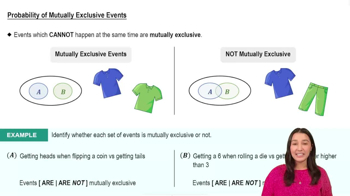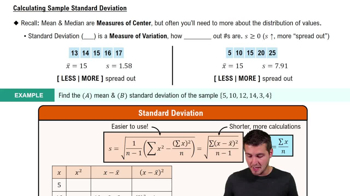Estimating s The sample of 92 roller coaster maximum speeds includes values ranging from a low of 10 km/h to a high of 194 km/h. Use the range rule of thumb to estimate the standard deviation.
Table of contents
- 1. Intro to Stats and Collecting Data1h 14m
- 2. Describing Data with Tables and Graphs1h 55m
- 3. Describing Data Numerically2h 5m
- 4. Probability2h 16m
- 5. Binomial Distribution & Discrete Random Variables3h 6m
- 6. Normal Distribution and Continuous Random Variables2h 11m
- 7. Sampling Distributions & Confidence Intervals: Mean3h 23m
- Sampling Distribution of the Sample Mean and Central Limit Theorem19m
- Distribution of Sample Mean - Excel23m
- Introduction to Confidence Intervals15m
- Confidence Intervals for Population Mean1h 18m
- Determining the Minimum Sample Size Required12m
- Finding Probabilities and T Critical Values - Excel28m
- Confidence Intervals for Population Means - Excel25m
- 8. Sampling Distributions & Confidence Intervals: Proportion1h 25m
- 9. Hypothesis Testing for One Sample3h 29m
- 10. Hypothesis Testing for Two Samples4h 50m
- Two Proportions1h 13m
- Two Proportions Hypothesis Test - Excel28m
- Two Means - Unknown, Unequal Variance1h 3m
- Two Means - Unknown Variances Hypothesis Test - Excel12m
- Two Means - Unknown, Equal Variance15m
- Two Means - Unknown, Equal Variances Hypothesis Test - Excel9m
- Two Means - Known Variance12m
- Two Means - Sigma Known Hypothesis Test - Excel21m
- Two Means - Matched Pairs (Dependent Samples)42m
- Matched Pairs Hypothesis Test - Excel12m
- 11. Correlation1h 6m
- 12. Regression1h 50m
- 13. Chi-Square Tests & Goodness of Fit1h 57m
- 14. ANOVA1h 57m
3. Describing Data Numerically
Standard Deviation
Problem 3.2.41
Textbook Question
The Empirical Rule Based on Data Set 1 “Body Data” in Appendix B, blood platelet counts of women have a bell-shaped distribution with a mean of 255.1 and a standard deviation of 65.4. (All units are 1000 cells/) Using the empirical rule, what is the approximate percentage of women with platelet counts
a. within 2 standard deviations of the mean, or between 124.3 and 385.9?
 Verified step by step guidance
Verified step by step guidance1
Step 1: Recall the Empirical Rule, which states that for a bell-shaped (normal) distribution: approximately 68% of the data falls within 1 standard deviation of the mean, 95% within 2 standard deviations, and 99.7% within 3 standard deviations.
Step 2: Identify the given values from the problem. The mean (μ) is 255.1, and the standard deviation (σ) is 65.4. The range of interest is within 2 standard deviations of the mean, which corresponds to the interval [μ - 2σ, μ + 2σ].
Step 3: Calculate the lower bound of the interval by subtracting 2 standard deviations from the mean: μ - 2σ = 255.1 - 2(65.4).
Step 4: Calculate the upper bound of the interval by adding 2 standard deviations to the mean: μ + 2σ = 255.1 + 2(65.4).
Step 5: Using the Empirical Rule, conclude that approximately 95% of the data falls within 2 standard deviations of the mean. Therefore, the percentage of women with platelet counts between the calculated lower and upper bounds is approximately 95%.
 Verified video answer for a similar problem:
Verified video answer for a similar problem:This video solution was recommended by our tutors as helpful for the problem above
Video duration:
2mPlay a video:
Was this helpful?
Key Concepts
Here are the essential concepts you must grasp in order to answer the question correctly.
Empirical Rule
The Empirical Rule, also known as the 68-95-99.7 rule, states that for a normal distribution, approximately 68% of the data falls within one standard deviation of the mean, about 95% falls within two standard deviations, and around 99.7% falls within three standard deviations. This rule helps in understanding the spread of data in a bell-shaped distribution.
Recommended video:

Probability of Mutually Exclusive Events
Standard Deviation
Standard deviation is a measure of the amount of variation or dispersion in a set of values. A low standard deviation indicates that the values tend to be close to the mean, while a high standard deviation indicates that the values are spread out over a wider range. In this context, it helps quantify how platelet counts vary among women.
Recommended video:
Guided course

Calculating Standard Deviation
Normal Distribution
A normal distribution is a probability distribution that is symmetric about the mean, showing that data near the mean are more frequent in occurrence than data far from the mean. It is characterized by its bell-shaped curve, where the mean, median, and mode are all equal. Understanding this concept is crucial for applying the Empirical Rule effectively.
Recommended video:
Guided course

Finding Standard Normal Probabilities using z-Table

 8:45m
8:45mWatch next
Master Calculating Standard Deviation with a bite sized video explanation from Patrick
Start learningRelated Videos
Related Practice
Textbook Question
